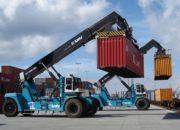Forklift Hyundai
Hyundai is a famous Korean forklift brand that is not only famous and won the trust of most users for its long life but also famous for its good product quality, diverse models and extended warranty period. up to 3000 hours through authorized Hyundai dealers. This is one of the plus points that Hyundai gives customers complete peace of mind in their products.
When you choose to buy or rent a Hyundai forklift, you can be assured of the quality Hyundai Forklift is specially designed to meet the requirements of handling, loading and unloading goods and materials. In particular, hyundai forklifts have a long life, little damage and great value when reselling when old.
Most new Hyundai Electric, Diesel and LPG forklifts come with a standard 2-year or 3000-hour manufacturing warranty (or 4000 hours on the B-7A series).
Samcovina is the official dealer of Hyundai forklifts in Vietnam. We have more than 14 years of experience operating in the field of selling and renting forklifts, of which Hyundai branded forklift is one of our key brands. Samcovina company sells and leases all lines of Hyundai forklifts such as hand trucks, electric forklifts, diesel forklifts from 2 tons (2 tons, 2.5 tons, 3 tons…) to 35 tons. Especially, we are the official dealer and directly import 100% genuine new complete Hyundai forklift trucks, so the price is reasonable, competitive, high quality and warranty – maintenance up to 2 years (3000 hours). .
On the other hand, we import 100% new, original Hyundai forklifts regularly and continuously and display a large number of Hyundai forklifts at our main facility of more than 3000 square meters at Binh Duong Boulevard, Binh Duong province. and two large branch yards of our company in District 9, TP. Ho Chi Minh City and Dong Nai in order to create favorable conditions for customers in Binh Duong, Dong Nai, City. Ho Chi Minh City and neighboring provinces come to choose forklifts that are suitable for the actual needs of businesses.
How do we deliver higher quality, more durable, more reliable forklifts at a lower cost? Our company Samcovina is constantly trying to find and promote cooperation with famous forklift brands in the world in order to find stable and quality import sources with reasonable prices. At the same time, we are constantly looking for skilled engineers, technicians and professionals to improve the qualifications of the technical team for the purpose of maintaining, checking or fixing any errors in time. the fastest. From there, helping customers save costs is the first basis for a lower cost of ownership. When you choose Samcovina, you can feel confident that you’re getting the best value in the industry.
Our motto is that we don’t just want to sell you or rent a forklift, we want to build a partnership with you, with your business. We understand your revenue is tied to the productivity and efficiency of your lifting equipment. So we have a great responsibility to stand behind our products, make sure the best warranty, maintain or fix the problem in the fastest way, the best consulting service and become a one of the best companies in the industry.
xe nâng, xe nâng điện






